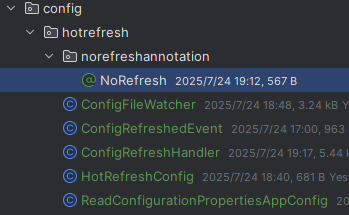spring boot 2.5.x配置属性热更新的轻量级实现方案--【开发阶段配置】
- 工作小总结&小工具类
- 时间:2025-07-25 11:52
- 369人已阅读
🔔🔔🔔好消息!好消息!🔔🔔🔔
有需要的朋友👉:联系凯哥
项目开发中,每次修改配置(比如调整接口超时时间、限流阈值)都要重启服务,不仅开发效率低,线上重启还会导致短暂不可用。
虽然Spring Cloud Config、Apollo这类配置中心能解决问题,但对于中小项目来说太重了——要部署服务,成本太高。
今天分析一个轻量级方案,基于SpringBoot原生能力实现配置热更新,不用额外依赖,代码量不到200行。
一、为什么需要“轻量级”热更新?
先说说传统配置方案的痛点
痛点1:改配置必须重启服务
开发环境中,改个日志级别都要重启服务,浪费时间;生产环境更麻烦,重启会导致流量中断,影响用户体验。
痛点2:重量级配置中心成本高
Spring Cloud Config、Apollo功能强大,但需要单独部署服务、维护元数据,小项目用不上这么复杂的功能,纯属“杀鸡用牛刀”。
痛点3:@Value注解不支持动态刷新
即使通过@ConfigurationProperties绑定配置,默认也不会自动刷新,必须结合@RefreshScope,但@RefreshScope会导致Bean重建,可能引发状态丢失。
我们需要什么?
• 无需额外依赖,基于SpringBoot原生API
• 支持properties/yaml文件热更新
• 不重启服务,修改配置后自动生效
• 对业务代码侵入小,改造成本低
二、核心原理:3个关键技术点
轻量级热更新的实现依赖SpringBoot的3个原生能力,不需要引入任何第三方框架
2.1 配置文件监听:WatchService
Java NIO提供的WatchService可以监听文件系统变化,当配置文件(如application.yml)被修改时,能触发回调事件。
2.2 属性刷新:Environment与ConfigurationProperties
Spring的Environment对象存储了所有配置属性,通过反射更新其内部的PropertySources,可以实现配置值的动态替换。
同时,@ConfigurationProperties绑定的Bean需要重新绑定属性,这一步可以通过ConfigurationPropertiesBindingPostProcessor实现。
2.3 事件通知:ApplicationEvent
自定义一个ConfigRefreshEvent事件,当配置更新后发布事件,业务代码可以通过@EventListener接收通知,处理特殊逻辑(如重新初始化连接池)。
三、手把手实现:不到200行代码
结构:

3.1 第一步:监听配置文件变化
创建ConfigFileWatcher类,使用WatchService监听application.yml或application.properties的修改
import lombok.extern.slf4j.Slf4j;
/**
* @BelongsProject:
* @BelongsPackage: com.kaigejava.common.config
* @Author: kaigejava
* @CreateTime: 2025-07-24 15:41
* @Description: 监听配置文件变化
* 创建ConfigFileWatcher类,使用WatchService监听application.yml或application.properties的修改
* @Version: 1.0
*/
import javax.annotation.PostConstruct;
import javax.annotation.PreDestroy;
import org.springframework.core.io.FileSystemResource;
import org.springframework.core.io.Resource;
import org.springframework.util.ResourceUtils;
import java.io.IOException;
import java.nio.file.*;
import java.util.concurrent.ExecutorService;
import java.util.concurrent.Executors;
@Slf4j
public class ConfigFileWatcher {
private final String configPath = "classpath:application.yml";
private WatchService watchService;
private final ExecutorService executor = Executors.newSingleThreadExecutor();
private final ConfigRefreshHandler refreshHandler;
private long lastProcessTime;
private final long EVENT_DEBOUNCE_TIME = 500;
public ConfigFileWatcher(ConfigRefreshHandler refreshHandler) {
this.refreshHandler = refreshHandler;
}
@PostConstruct
public void init() throws IOException {
Resource resource = new FileSystemResource(ResourceUtils.getFile(configPath));
Path configDir = resource.getFile().toPath().getParent();
String fileName = resource.getFilename();
watchService = FileSystems.getDefault().newWatchService();
configDir.register(watchService, StandardWatchEventKinds.ENTRY_MODIFY);
executor.submit(() -> {
while (true) {
try {
WatchKey key = watchService.take();
if (System.currentTimeMillis() - lastProcessTime < EVENT_DEBOUNCE_TIME) {
continue;
}
for (WatchEvent<?> event : key.pollEvents()) {
WatchEvent.Kind<?> kind = event.kind();
if (kind == StandardWatchEventKinds.OVERFLOW) {
continue;
}
Path changedFile = (Path) event.context();
if (changedFile.getFileName().toString().equals(fileName)) {
log.info("检测到配置文件修改:{}", fileName);
refreshHandler.refresh();
}
}
boolean valid = key.reset();
if (!valid) break;
} catch (InterruptedException e) {
Thread.currentThread().interrupt();
break;
}
}
});
log.info("配置文件监听器启动成功,监听路径:{}", configDir);
}
@PreDestroy
public void destroy() {
executor.shutdownNow();
try {
watchService.close();
} catch (IOException e) {
log.error("关闭WatchService失败", e);
}
}
}需要注意:classpath:application.yml 这个需要根据自己项目修改成自己的。
比如有些喜欢写成:application.yaml
3.2 第二步:实现配置刷新逻辑
创建ConfigRefreshHandler类,核心功能是更新Environment中的属性,并通知@ConfigurationProperties Bean刷新
import com.kaigejava.config.hotrefresh.norefreshannotation.NoRefresh;
import lombok.extern.slf4j.Slf4j;
import org.springframework.beans.BeansException;
import org.springframework.beans.factory.annotation.Autowired;
import org.springframework.beans.factory.config.YamlPropertiesFactoryBean;
import org.springframework.boot.context.properties.ConfigurationProperties;
import org.springframework.boot.context.properties.bind.Bindable;
import org.springframework.boot.context.properties.bind.Binder;
import org.springframework.context.ApplicationContext;
import org.springframework.context.ApplicationContextAware;
import org.springframework.core.env.ConfigurableEnvironment;
import org.springframework.core.env.MapPropertySource;
import org.springframework.core.env.PropertySource;
import org.springframework.core.io.ClassPathResource;
import org.springframework.core.io.Resource;
import org.springframework.stereotype.Component;
import java.io.IOException;
import java.util.*;
@Component
@Slf4j
public class ConfigRefreshHandler implements ApplicationContextAware {
@Autowired
private ConfigurableEnvironment environment;
private ApplicationContext applicationContext;
public void refresh() {
try {
Properties properties = loadConfigFile();
Set<String> changeKeys = updateEnvironment(properties);
if (!changeKeys.isEmpty()) {
rebindConfigurationProperties();
}
applicationContext.publishEvent(new ConfigRefreshedEvent(this, changeKeys));
log.info("配置文件刷新完成");
} catch (Exception e) {
log.error("配置文件刷新失败", e);
}
}
private Properties loadConfigFile() throws IOException {
Resource resource = new ClassPathResource("application.yml");
YamlPropertiesFactoryBean yamlFactory = new YamlPropertiesFactoryBean();
yamlFactory.setResources(resource);
Properties properties = yamlFactory.getObject();
if (properties == null) {
throw new IOException("Failed to load configuration file");
}
return properties;
}
private Set<String> updateEnvironment(Properties properties) {
Set<String> changedKeys = new HashSet<>();
PropertySource<?> appConfig = null;
for (PropertySource<?> ps : environment.getPropertySources()) {
if (ps.getName().contains("application.yml")) {
appConfig = ps;
break;
}
}
if (appConfig != null && appConfig instanceof MapPropertySource) {
Map<String, Object> sourceMap = new HashMap<>(((MapPropertySource) appConfig).getSource());
properties.forEach((k, v) -> {
String key = k.toString();
Object oldValue = sourceMap.get(key);
if (!Objects.equals(oldValue, v)) {
changedKeys.add(key);
}
sourceMap.put(key, v);
});
environment.getPropertySources().replace(appConfig.getName(), new MapPropertySource(appConfig.getName(), sourceMap));
} else {
// environment.getPropertySources().addFirst(new MapPropertySource("application.yml", properties));
}
return changedKeys;
}
private void rebindConfigurationProperties() {
String[] beanNames = applicationContext.getBeanNamesForAnnotation(ConfigurationProperties.class);
for (String beanName : beanNames) {
Object bean = applicationContext.getBean(beanName);
Class<?> clazz = bean.getClass();
// 检查是否带有 @NoRefresh 注解
if (clazz.isAnnotationPresent(NoRefresh.class)) {
log.info("跳过带有 @NoRefresh 注解的配置Bean:{}", beanName);
continue;
}
// 跳过 GenConfig,避免报错
if (bean.getClass().getName().equals("com.kaigejava.generator.config.GenConfig")
|| bean.getClass().getName().equals("com.alibaba.druid.spring.boot.autoconfigure.DruidDataSourceWrapper")) {
log.info("跳过 GenConfig 配置Bean刷新:{}", beanName);
continue;
}
// 正常进行绑定
ConfigurationProperties annotation = clazz.getAnnotation(ConfigurationProperties.class);
if (annotation != null) {
String prefix = annotation.prefix();
try {
Binder.get(environment).bind(prefix, Bindable.ofInstance(bean));
log.info("刷新配置Bean:{}", beanName);
} catch (Exception e) {
log.warn("跳过绑定失败的Bean [{}],原因:{}", beanName, e.getMessage());
}
}
}
}
@Override
public void setApplicationContext(ApplicationContext applicationContext) throws BeansException {
this.applicationContext = applicationContext;
}
}需要注意:NoRefresh 这个是自定义注解.作用是哪些类可以不用
// 跳过 GenConfig,避免报错
if (bean.getClass().getName().equals("com.kaigejava.generator.config.GenConfig")
|| bean.getClass().getName().equals("com.alibaba.druid.spring.boot.autoconfigure.DruidDataSourceWrapper")) {
log.info("跳过 GenConfig 配置Bean刷新:{}", beanName);
continue;
}这段代码是如果不使用注解的话,可以使用完整路径来过滤。
ConfigRefreshedEvent
这个类代码如下:
import org.springframework.context.ApplicationEvent;
import java.util.Set;
/**
* @BelongsProject:
* @BelongsPackage: com.kaigejava.business.config.autorefresh
* @Author: kaigejava
* @CreateTime: 2025-07-24 16:40
* @Description: 创建ConfigRefreshHandler类,核心功能是更新Environment中的属性,并通知@ConfigurationProperties Bean刷新
* @Version: 1.0
*/
/**
* 自定义配置刷新事件
*/
public class ConfigRefreshedEvent extends ApplicationEvent {
// 存储变化的配置键(可选,方便业务判断哪些配置变了)
private final Set<String> changedKeys;
public ConfigRefreshedEvent(Object source, Set<String> changedKeys) {
super(source);
this.changedKeys = changedKeys;
}
// 获取变化的配置键
public Set<String> getChangedKeys() {
return changedKeys;
}
}3.3 第三步:注册监听器Bean
在SpringBoot配置类中注册ConfigFileWatcher,使其随应用启动。这里使用类名:HotRefreshConfig
import org.springframework.context.annotation.Bean;
import org.springframework.context.annotation.Configuration;
import java.io.IOException;
@Configuration
public class HotRefreshConfig {
@Bean
public ConfigFileWatcher configFileWatcher(ConfigRefreshHandler refreshHandler) throws IOException {
return new ConfigFileWatcher(refreshHandler);
}
}3.4 第四步:使用@ConfigurationProperties绑定属性
创建业务配置类,用@ConfigurationProperties绑定配置,无需额外注解即可支持热更新
import lombok.Data;
import org.springframework.boot.context.properties.ConfigurationProperties;
import org.springframework.stereotype.Component;
@Data
@Component
@ConfigurationProperties(prefix = "business.config") // 绑定配置前缀
public class ReadConfigurationPropertiesAppConfig {
private int timeout = 3000; // 默认超时时间3秒
private int maxRetries = 2; // 默认重试次数2次
//test-key
private String testKey ;
}说明:
其中的testKey是对应配置文件的。
3.5 第五步:配置文件添加对应key
在application.yml 中添加如下配置
# 业务相关配置 business: # 业务动态配置相关 config: test-key: kaigejava test value 123
3.6 第五步:测试热更新效果
import com.kaigejava.business.config.hotrefresh.ReadConfigurationPropertiesAppConfig;
import com.kaigejava.business.config.hotrefresh.ConfigRefreshedEvent;
import lombok.extern.slf4j.Slf4j;
import org.springframework.beans.factory.annotation.Autowired;
import org.springframework.context.event.EventListener;
import org.springframework.web.bind.annotation.GetMapping;
import org.springframework.web.bind.annotation.RestController;
@RestController
@Slf4j
public class TestConfigController {
@Autowired
private ReadConfigurationPropertiesAppConfig appConfig;
@GetMapping("/config")
public ReadConfigurationPropertiesAppConfig getConfig() {
log.info("Accessing /config, testKey = {}", appConfig.getTestKey());
return appConfig; // 返回当前配置
}
// 监听配置刷新事件,可进行业务特殊处理
@EventListener(ConfigRefreshedEvent.class)
public void appConfigUpdate(ConfigRefreshedEvent event) {
/* event.getChangedKeys().forEach(
key -> log.info("配置项 {} 发生变化", key)
);*/
/*System.out.println("配置项发生变化,当前配置:" + appConfig.toString());
event.getChangedKeys().forEach(
key -> System.out.println("配置项发生变化,当前配置:" + key)
);*/
}
}然后通过http://localhsot:端口/config就可以看到效果了。
四、入坑须知
如果项目中开启了修改代码后自动部署。可以先注释掉。因为热部署会影响测试结果。
关闭热部署方法:
检查pom文件
查看pom文件中是否存在spring-boot-devtools 如果存在,注释掉
<dependency> <groupId>org.springframework.boot</groupId> <artifactId>spring-boot-devtools</artifactId> <optional>true</optional> </dependency>
2.检查配置文件
如果配置文件中配置了
# 服务模块 devtools: restart: # 热部署开关 enabled: true
把true修改成false.